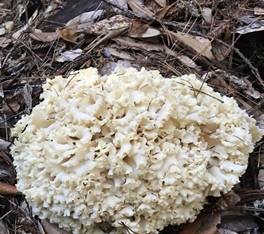WEST COAST UPDATE 10-13-2025

CAULIFLOWER MUSHROOM
The cauliflower mushroom is a globe-spanning genus whose best-known species, Sparassis crispa, was first described from Europe, while North America hosts close relatives. In the wild, cauliflower mushrooms fruit at the base of living or dead trees, often pines and other conifers, where they behave as weak parasites/saprobes and may reappear in the same spot for years, sometimes reaching “bushel-basket” size. Foragers value them because the ruffled fronds cook up springy and aromatic. In the kitchen they shine sautéed and “dry-sweated” first to drive off water, then finished with butter, tossed like pasta, slipped into soups and risottos, or breaded for tempura; they also dry and rehydrate beautifully. Nutritionally, like most mushrooms, cauliflower mushrooms are low in calories and fat, provide fiber and minerals, and—when dried—concentrate those β-glucans. Treat them as a savory, high-moisture vegetable with bonus functional polysaccharides rather than a major protein source. Altogether, this ruffled forest delicacy blends dependable habitats and repeat fruitings with standout texture and fragrance—one part forageable “pasta,” one part ongoing science story. ~2.6–3 g fiber, ~60–67 mg vitamin C, plus folate and potassium, composition varies by variety and ripeness. Cauliflower mushrooms are foraged in the USA, packed in five-pound boxes and are now in the market
Whats Hot
CAULIFLOWER
BABY BAKER POTATEO
MINNEOLA TANGELO
PUMELO
YELLOW MEAT WATERMELON
Whats Not
CAULININI
JAPANESE EGGPLANT
SALSIFY
GALANGA ROOT
LIMEQUATS